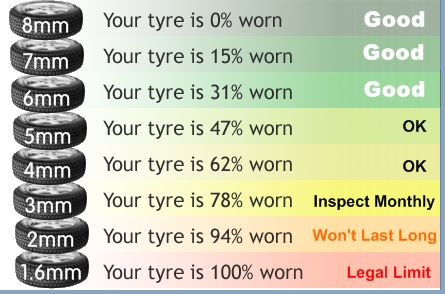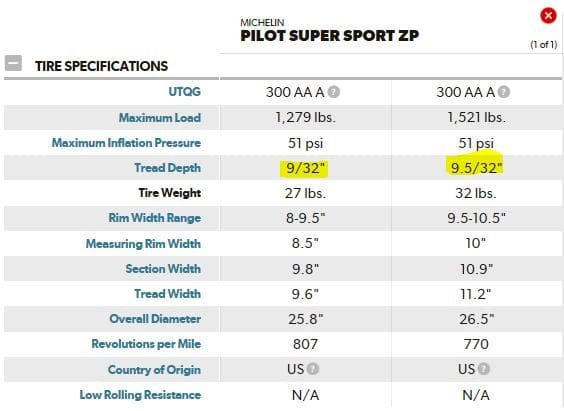
Pay special attention to areas that look the most worn. When performing the penny tire test, remember not only to check each tire, but to check various places around each tire. If it does, your tread is still above 2/32”, If you can see his entire head, it may be time to replace the tire because your tread is no longer deep enough. See if the top of his head disappears between the ribs. Turn the penny so that Lincoln’s head points down into the tread. A “rib” refers to the raised portion of tread that spans the circumference of your tire. Place a penny between the tread ribs on your tire. The idea of the penny test is to check whether you’ve hit the 2/32” threshold. Department of Transportation recommends replacing tires when they reach 2/32”, and many states legally require tires to be replaced at this depth. New tires typically come with 10/32” or 11/32” tread depths, and some truck, SUV and winter tires may have deeper tread depths than other models.
Tire tread depth gauge chart professional#
If you notice any of these signs, it's important to have your tires inspected by a professional to determine if they need to be replaced.In the United States, tire tread depth is measured in 32nds of an inch. In addition to checking the tread depth, you should also inspect your tires for other signs of wear, such as cracks, bulges, or uneven wear. If the tread is level with the wear bars, it's time to replace your tires. Most tires have wear bars, which are raised bars in the tread that indicate when the tire tread depth is at or below the minimum safe level.

It's important to regularly check the tread depth of your tires to ensure that they are in good condition and providing adequate traction. Additionally, tire wear can vary across the tire, so it's important to check the tread depth at multiple points around the tire to get a complete picture of the tire's condition. It's important to note that the penny test is only a rough estimate of tire tread depth, and it's recommended to use a tire tread depth gauge for a more accurate measurement. If the top of Lincoln's head is visible, the tire tread depth is below the minimum safe level and the tires should be replaced. If the top of Lincoln's head is covered by the tire tread, the tire tread depth is at or above the minimum safe level.Place a penny in the tire tread with Lincoln's head facing down and perpendicular to the tire.Most tire tread depth gauges have a digital display or a dial with markings in millimeters or inches.Īnother way to measure tire tread depth is to use a penny. Read the tire tread depth on the gauge.Press the gauge firmly against the tire to ensure an accurate reading.Place the gauge on the tire tread at the center of the tire, making sure that the probe is perpendicular to the tire and fully seated in the tread grooves.

To use a tire tread depth gauge, follow these steps: One simple method is to use a tire tread depth gauge, which is a tool specifically designed for this purpose. There are several ways to measure tire tread depth. It can also increase the risk of a tire blowout or failure, which can be dangerous at high speeds. This can lead to poor handling and braking, especially in wet or slippery conditions. As the tire tread wears down, the tire's ability to grip the road and provide traction is reduced. For example, driving on rough roads or under-inflated tires can cause the tire tread to wear down faster.

This can be caused by a variety of factors, including driving habits, road conditions, and the type of vehicle you drive. How does tire wear affect tire performance?Īs tires are used, the tread on the tire gradually wears down. The minimum legal tire tread depth for passenger vehicles in the United States is 2/32 of an inch. When a tire's tread depth is too low, the tire's performance can be compromised, leading to reduced traction and increased risk of hydroplaning or skidding. This is important because it determines the tire's ability to grip the road and provide traction, especially in wet or slippery conditions. Tire tread depth is a measure of the amount of rubber on the tire that comes into contact with the road. In this blog post, we'll explain what tire tread depth is, how tire wear affects tire performance, how-to measure tire tread wear, and when you should replace your tires. One key aspect of tire condition is the tire tread depth, which is a measure of the amount of rubber on the tire that comes into contact with the road. When it comes to maintaining the safety and performance of your vehicle, the condition of your tires is one of the most important factors to consider.


 0 kommentar(er)
0 kommentar(er)
